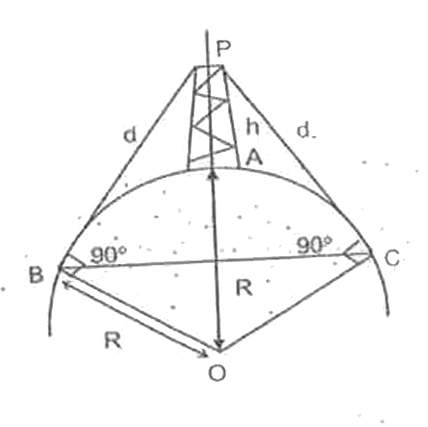Assertion: The television signals are propagated through sky waves. Reason: Television signals have freqeuncy in the range of 1000MHz to 2000MHz range.
a) A and R both are true and R is correct explaination of A
b) A is true but R is false
c) A is false but R is true
d) Both are false
The correct Answer is:D
To analyze the assertion and reason provided in the question, we will break down the concepts of television signal propagation and frequency ranges.
1. Understanding the Assertion:
- The assertion states that "The television signals are propagated through sky waves."
- Sky wave propagation typically occurs when radio waves are reflected back to Earth by the ionosphere. This method is effective for frequencies in the range of about 3 MHz to 30 MHz.
2. Understanding the Reason:
- The reason given is that "Television signals have frequency in the range of 1000 MHz to 2000 MHz."
- Television signals indeed operate at much higher frequencies, typically ranging from 470 MHz to 890 MHz for digital television, and can extend up to 2000 MHz for certain types of transmissions.
3. Comparing the Assertion and Reason:
- Since television signals operate at frequencies much higher than the typical range for sky wave propagation, the assertion that they are propagated through sky waves is incorrect.
- Additionally, the reason provided states the frequency range of television signals accurately, but it does not support the assertion since these frequencies do not fall within the effective range for sky wave propagation.
4. Conclusion:
- Both the assertion and the reason are incorrect in the context of sky wave propagation for television signals.
- Therefore, the correct conclusion is that the assertion is false and the reason is also false.
Final Answer:
Both the assertion and the reason are incorrect.
---
- The assertion states that "The television signals are propagated through sky waves."
- Sky wave propagation typically occurs when radio waves are reflected back to Earth by the ionosphere. This method is effective for frequencies in the range of about 3 MHz to 30 MHz.
- The reason given is that "Television signals have frequency in the range of 1000 MHz to 2000 MHz."
- Television signals indeed operate at much higher frequencies, typically ranging from 470 MHz to 890 MHz for digital television, and can extend up to 2000 MHz for certain types of transmissions.
- Since television signals operate at frequencies much higher than the typical range for sky wave propagation, the assertion that they are propagated through sky waves is incorrect.
- Additionally, the reason provided states the frequency range of television signals accurately, but it does not support the assertion since these frequencies do not fall within the effective range for sky wave propagation.
- Both the assertion and the reason are incorrect in the context of sky wave propagation for television signals.
- Therefore, the correct conclusion is that the assertion is false and the reason is also false.
Both the assertion and the reason are incorrect.
Topper's Solved these Questions
- COMMUNITCATION SYSTEMSBOOK - NCERT FINGERTPS ENGLISHCHAPTER - COMMUNITCATION SYSTEMSEXERCISE - Introduction
2 Videos
- COMMUNITCATION SYSTEMSBOOK - NCERT FINGERTPS ENGLISHCHAPTER - COMMUNITCATION SYSTEMSEXERCISE - Elements Of A Communication System
4 Videos
- COMMUNITCATION SYSTEMSBOOK - NCERT FINGERTPS ENGLISHCHAPTER - COMMUNITCATION SYSTEMSEXERCISE - NCERT
9 Videos
- ATOMS BOOK - NCERT FINGERTPS ENGLISHCHAPTER - ATOMS EXERCISE - Assertion And Reason
15 Videos
- CURRENT ELECTRICITYBOOK - NCERT FINGERTPS ENGLISHCHAPTER - CURRENT ELECTRICITYEXERCISE - Assertion And Reason
15 Videos
Similar Questions
Knowledge Check
Assertion : The radio and TV signals from broadcasting stations carry energy.
Reason : Electromagnetic waves are capable to carry energy from one place to another.AIf both assertion and reason are true and reason is the correct explanation of assertionBIf both assertion and reason are true but reason is not the correct explanation of assertionCIf assertion is true but reason is falseDIf both assertion and reason are false
Television signals reach us only through ground waves. The range R is related to the height h of the transmitter antenna as
View SolutionStatement-I : Television signals are received through sky-wave propagation
Statement-II : The ionosphere reflects electromagnetic waves of frequencies greater than a certain critical frequency.
View SolutionThe mode of propagation used by short wave broadcast services having a frequency range from a few 3MHzup to 30MHz is
View SolutionAssertion: The surface wave propagation is used for medium wave band and for television broadcasting.
Reason: The surface waves travel directly from transmitting antenna to receiver antenna through atmosphere.
View SolutionAssertion: The loss of strength of a signal while propagating through a medium is known as attenuation.
Reason: Transmitter helps to avoid attenuation.
View SolutionAssertion: The loss of strength of a signal while propagating through a medium is known as attenuation.
Reason: Transmitter helps to avoid attenuation.
View SolutionWould sky waves be suitable for transmission of TV signals of 60 MHz frequency?
View Solution

